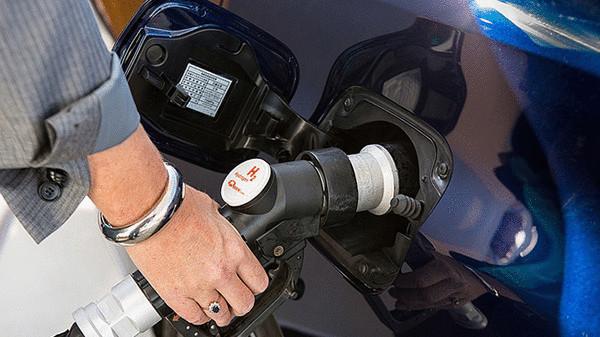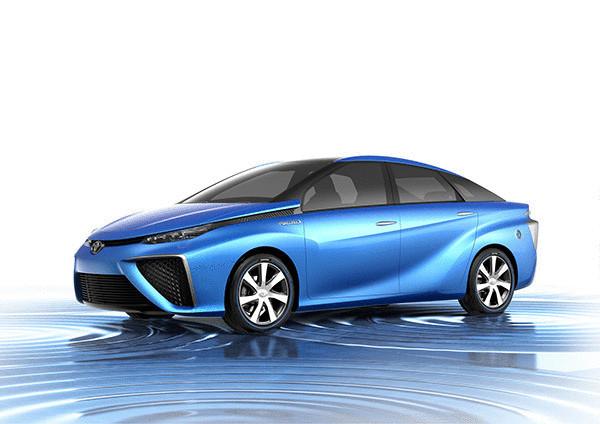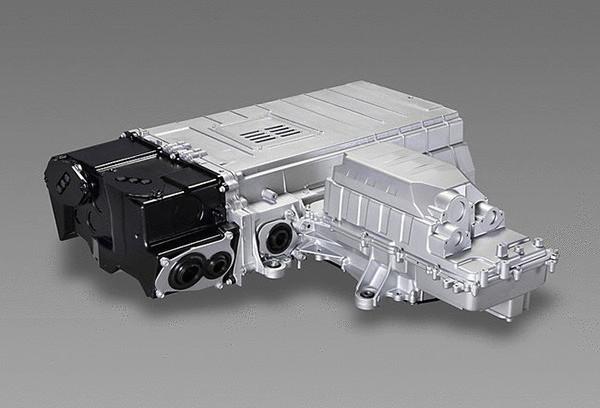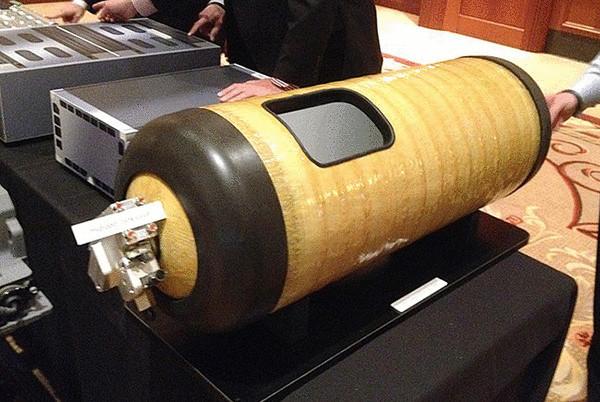Interesting facts about hydrogen fuel and vehicles powered by fuel cells
 Bashny.Net
Bashny.Net
After many restarts and closures over the last 20 years hydrogen-powered car (FCV – FuelCellVehicles) finally go on the road. Led by Toyota with its Mirai FCV model, which will be available next year, several automakers said added hydrogen vehicles in its range, including the Hyundai Tucson FCV and Audi A7 h-tron.

Regardless of whether you agree that hydrogen is the best way to rid our dependence on fossil fuels or seriously doubt the ability of technology to establish a position (and that she really "greener" than other types of fuel), get acquainted with some interesting facts about hydrogen fuel and vehicles powered by fuel cells.
Hydrogen is the most abundant material in the known Universe. Unfortunately it is difficult to find in pure form on Earth.
Hydrogen has long been used for lighting the housing, along with other gases, long before the discovery of electricity.
Toyota began work on fuel cell technology about 20 years ago, simultaneously with a gasoline-electric hybrid Prius.

Toyota gave its engineers 36 months to the conclusion of the concept of the Prius hybrid on the road. Fuel cells need much more time.
In the mid-90s, some experts called hybrid cars purely scientific experiment, nothing more. The same thing is happening with FCV.
Nobody expects that users in one night will take the FCV. Hybrid Prius took 10 years. In these 10 years it has been sold only 1 million hybrids, and for the next several years, sold 7 million.
Automakers positioned on FCV as a replacement for hybrids, electric vehicles and even conventional gasoline engines. They see them as an additional choice for those who want to choose a "green" lifestyle.

Hydrogen can be obtained from many sources, including wind, solar radiation and even garbage, not just natural gas. Hydrogen fuel station in fountain valley, Newport beach, California, receives fuel from sewage treatment plants orange County, where the hydrogen is produced using the so-called process of "three-generation" — sewage turned into electricity, heat and hydrogen before the treated water goes into the Pacific ocean.
Excess solar and wind energy, which is usually not used can be stored in the form of hydrogen fuel. In Denmark, for example, surplus wind energy and it is with open arms waiting for mass arrival of FCV on the local market.
Technologies for capturing carbon dioxide released during the production of hydrogen, are under development.
In liquid form hydrogen has high density and easy to transport.
The calorific value of hydrogen is several times higher than that of gasoline. Only 5 kg of hydrogen will provide a full-size sedan with the energy of 500 kilometers, which is two times more than the same volume of gasoline.

Hydrogen fuel cells are already being used in stationary generators, replacing batteries and diesel generators. Toyota Mirai can power the whole house during the week with 5 kg of hydrogen in its tanks paired.
1 kilogram of hydrogen is equivalent to 1 gallon of gasoline.
The reaction between hydrogen and oxygen produces electricity in addition to water. This water is released as steam from the exhaust pipe. You can also drain the water using the switch before you Park to avoid freezing in the winter.
A computer program Street is used to determine the optimal number of gas stations with hydrogen. To ensure the Gulf coast, San Francisco, Silicon Valley, Los Angeles, orange counties and San Diego – with the expectation that the owners will get to a gas station a maximum of 6 minutes – you only need 68 stations. They do not need to sculpt every corner, as in the case of oil-derived waxes fuels.
Currently in California there are 10 active stations. The budget has been approved, and to 2016mu year in the state must be built 100 hydrogen stations.
The rest of the world just waiting for hydrogen cars:
Germany will build 100 stations by 2020, Japan's ambitious signed up for the hundred until 2016, UK, which is now 15, expects by 2020 to open 65 stations. Korea has plans to open 160 stations by 2020. Denmark plans to build another 15 stations by 2020 and to use excess wind energy to produce hydrogen.
It is expected that fuel cost will be $10 per kilogram in the US market, and if you take two times more mileage per unit of fuel, you get $5 per gallon equivalent cost.
The average lifespan of a fuel cell of about 250,000 kilometers.
Tanks for hydrogen, which uses Toyota's bulletproof. They are woven from super strong fibers on the machines, produced the same Toyota Corp in 1926. In a fully filled tank shots were fired from large-caliber weapons to explore its durability. And only bullet caliber 50 was able to penetrate the tank, hitting the same place twice. For this test, Toyota has hired two former military snipers.

And finally, during the crash tests revealed that the steel structure that surrounds a tank, has a much lower strength. published
P. S. And remember, only by changing their consumption — together we change the world! ©
Source: www.ekopower.ru/?p=3165

Regardless of whether you agree that hydrogen is the best way to rid our dependence on fossil fuels or seriously doubt the ability of technology to establish a position (and that she really "greener" than other types of fuel), get acquainted with some interesting facts about hydrogen fuel and vehicles powered by fuel cells.
Hydrogen is the most abundant material in the known Universe. Unfortunately it is difficult to find in pure form on Earth.
Hydrogen has long been used for lighting the housing, along with other gases, long before the discovery of electricity.
Toyota began work on fuel cell technology about 20 years ago, simultaneously with a gasoline-electric hybrid Prius.

Toyota gave its engineers 36 months to the conclusion of the concept of the Prius hybrid on the road. Fuel cells need much more time.
In the mid-90s, some experts called hybrid cars purely scientific experiment, nothing more. The same thing is happening with FCV.
Nobody expects that users in one night will take the FCV. Hybrid Prius took 10 years. In these 10 years it has been sold only 1 million hybrids, and for the next several years, sold 7 million.
Automakers positioned on FCV as a replacement for hybrids, electric vehicles and even conventional gasoline engines. They see them as an additional choice for those who want to choose a "green" lifestyle.

Hydrogen can be obtained from many sources, including wind, solar radiation and even garbage, not just natural gas. Hydrogen fuel station in fountain valley, Newport beach, California, receives fuel from sewage treatment plants orange County, where the hydrogen is produced using the so-called process of "three-generation" — sewage turned into electricity, heat and hydrogen before the treated water goes into the Pacific ocean.
Excess solar and wind energy, which is usually not used can be stored in the form of hydrogen fuel. In Denmark, for example, surplus wind energy and it is with open arms waiting for mass arrival of FCV on the local market.
Technologies for capturing carbon dioxide released during the production of hydrogen, are under development.
In liquid form hydrogen has high density and easy to transport.
The calorific value of hydrogen is several times higher than that of gasoline. Only 5 kg of hydrogen will provide a full-size sedan with the energy of 500 kilometers, which is two times more than the same volume of gasoline.

Hydrogen fuel cells are already being used in stationary generators, replacing batteries and diesel generators. Toyota Mirai can power the whole house during the week with 5 kg of hydrogen in its tanks paired.
1 kilogram of hydrogen is equivalent to 1 gallon of gasoline.
The reaction between hydrogen and oxygen produces electricity in addition to water. This water is released as steam from the exhaust pipe. You can also drain the water using the switch before you Park to avoid freezing in the winter.
A computer program Street is used to determine the optimal number of gas stations with hydrogen. To ensure the Gulf coast, San Francisco, Silicon Valley, Los Angeles, orange counties and San Diego – with the expectation that the owners will get to a gas station a maximum of 6 minutes – you only need 68 stations. They do not need to sculpt every corner, as in the case of oil-derived waxes fuels.
Currently in California there are 10 active stations. The budget has been approved, and to 2016mu year in the state must be built 100 hydrogen stations.
The rest of the world just waiting for hydrogen cars:
Germany will build 100 stations by 2020, Japan's ambitious signed up for the hundred until 2016, UK, which is now 15, expects by 2020 to open 65 stations. Korea has plans to open 160 stations by 2020. Denmark plans to build another 15 stations by 2020 and to use excess wind energy to produce hydrogen.
It is expected that fuel cost will be $10 per kilogram in the US market, and if you take two times more mileage per unit of fuel, you get $5 per gallon equivalent cost.
The average lifespan of a fuel cell of about 250,000 kilometers.
Tanks for hydrogen, which uses Toyota's bulletproof. They are woven from super strong fibers on the machines, produced the same Toyota Corp in 1926. In a fully filled tank shots were fired from large-caliber weapons to explore its durability. And only bullet caliber 50 was able to penetrate the tank, hitting the same place twice. For this test, Toyota has hired two former military snipers.

And finally, during the crash tests revealed that the steel structure that surrounds a tank, has a much lower strength. published
P. S. And remember, only by changing their consumption — together we change the world! ©
Source: www.ekopower.ru/?p=3165
Tags
See also
Interesting facts about pornography
5 horrifying facts about the normal rats (5 photos)
Interesting facts about mosquitoes
37 most interesting facts
Interesting facts from the shooting
Facts about sprats
Interesting facts about sprats
Ten informative and interesting facts
Question colors - interesting facts about the color!
Cult "Matrix" for 15 years. 15 interesting facts

















